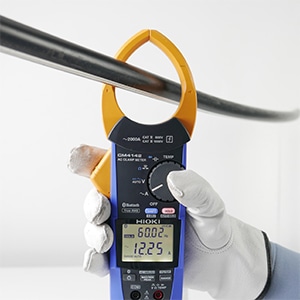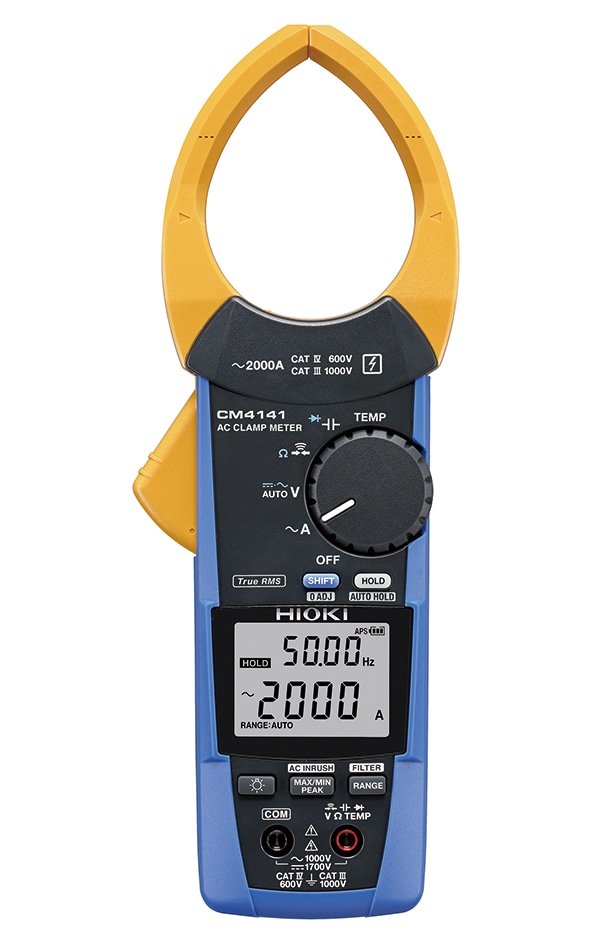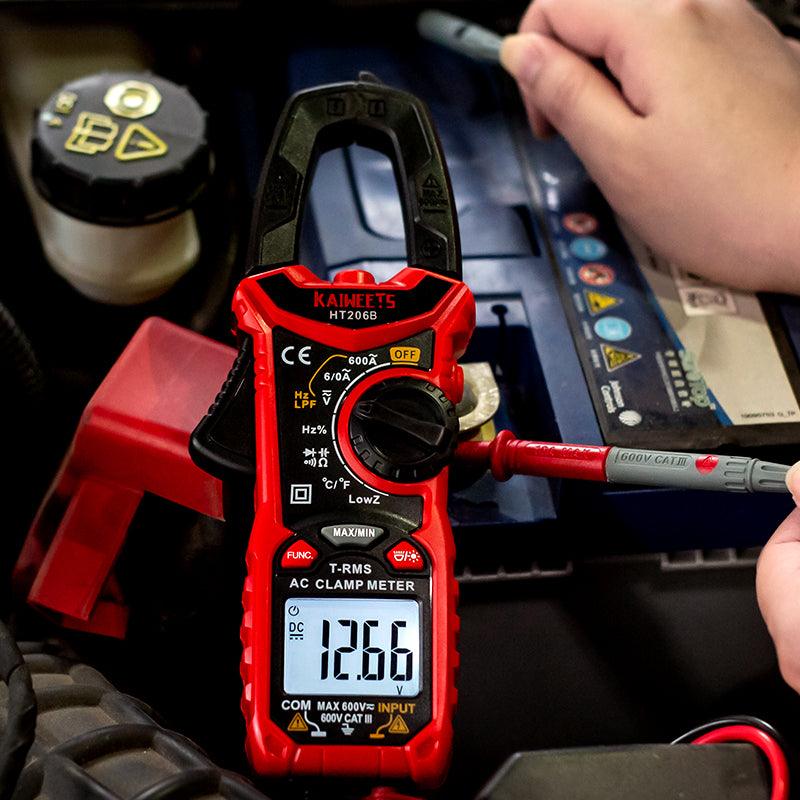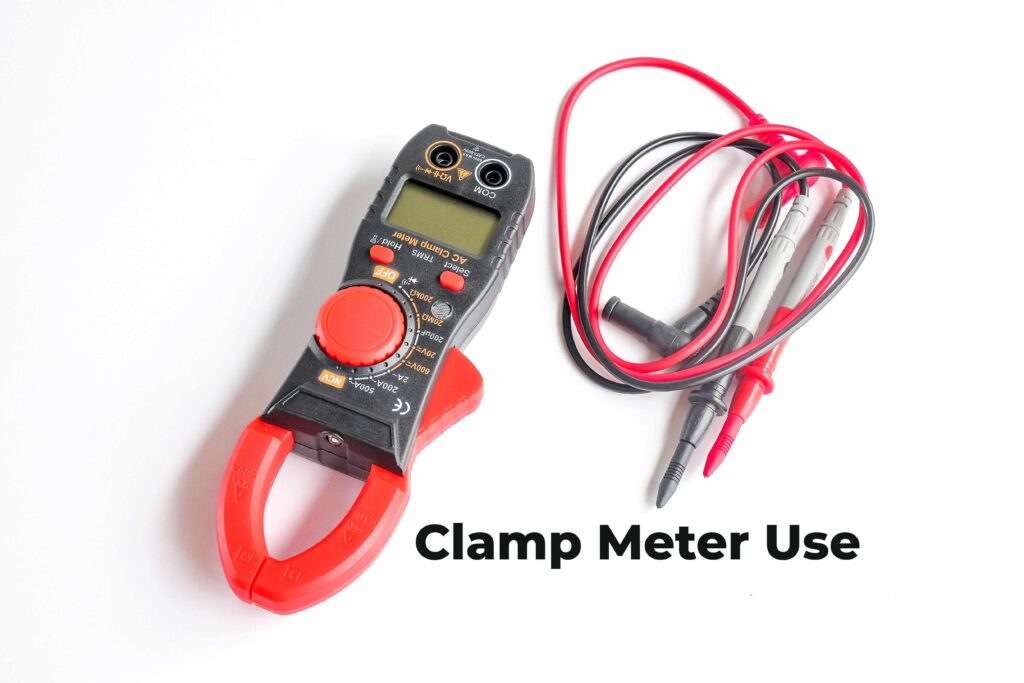A clamp meter measures electrical current without disconnecting the circuit. It clamps around a conductor to take readings.
Understanding the functionality of a clamp meter is crucial for electrical diagnostics and maintenance. This handheld device offers a quick and efficient way to measure the flow of electricity in a conductor without disrupting the system. Its non-intrusive measuring technique allows for safe readings, which is particularly useful for high current systems.
Clamp meters are versatile tools that not only measure current but often voltage and resistance as well. Electricians and technicians favor them for their ease of use and the ability to test circuits without direct contact with the wires. With safety and convenience at the forefront, clamp meters have become an indispensable tool in the field of electrical work, ensuring accurate measurements and promoting a safer working environment.
Types Of Clamp Meters
Clamp meters are essential tools for electrical measurements. They safely measure high currents without direct contact with the conductor. Each type serves a different purpose. Understanding these types helps choose the right tool for the job.
Basic Clamp Meters
Basic clamp meters perform fundamental tasks. They measure current (AC and DC), voltage, and resistance.
- AC Clamp Meters: Measure alternating current in wires without cutting insulation.
- DC Clamp Meters: Measure direct current, often used in automotive applications.
They suit most home or basic industrial tasks. Their features include:
- Digital displays for easy reading
- Auto-ranging for convenience
- Resistance and continuity checks
Advanced Clamp Meters
Advanced clamp meters offer more features. Professionals use them for complex diagnostics.
| Feature | Benefit |
|---|---|
| Inrush Current Measurement | Capture motor startup current |
| True RMS | Accurate readings on non-linear loads |
| Temperature Measurement | Check heating issues without contact |
These meters often include:
- Data logging capabilities
- Wireless connectivity for data transfer
- Backlit screens for low-light conditions

Credit: www.hioki.com
How To Use A Clamp Meter
Mastering the use of a clamp meter can transform the way you measure electrical currents. It’s a tool that combines a voltmeter with a clamp-type current meter. Unlike traditional multimeters, a clamp meter allows you to measure currents without breaking the circuit. This section will guide you through the process, ensuring accuracy and safety in your measurements.
Preparing The Clamp Meter
Before taking any measurements, proper preparation is crucial. Start by ensuring your clamp meter is in good working condition. Check the battery life and make sure the display is clear. Set the meter to the correct measurement type, such as AC or DC current, based on your needs. Select the range that best fits the expected current. If unsure, start with the highest range and adjust downward as necessary. Always inspect the clamp jaws; they should be clean and close properly.
Taking Measurements Safely
Electrical measurements must prioritize safety. First, always verify that the meter’s rating is suitable for the system you’re testing. Wear protective gear, like gloves and goggles, to safeguard against electrical hazards. When ready to measure, press the clamp meter’s trigger to open the jaws. Carefully encircle one wire – never both, as this will result in an incorrect reading. Close the jaws around the wire, ensuring a snug fit without pinching.
Observe the reading on the display, keeping your hands on the insulated parts of the clamp meter. If the reading stabilizes, note it down. If it fluctuates, check connections and ensure the wire is centered in the jaws. Once the measurement is complete, release the wire and turn off the clamp meter. Remove your protective gear and store the meter safely for future use.
With these steps, using a clamp meter is straightforward and safe. Proper preparation and adherence to safety guidelines ensure reliable measurements every time.
Common Applications
Clamp meters are versatile tools used in various fields. They measure electrical current without needing direct contact. This makes them safe and efficient for many applications.
Electrical Testing
Professionals use clamp meters to test electrical systems. They ensure systems are safe and working properly. Here are some key uses:
- Check current load: Technicians measure the current flowing through a circuit. This helps prevent overload.
- Identify faults: Clamp meters detect irregularities. This helps in maintaining electrical safety.
- Measure efficiency: By checking the power consumption, technicians assess appliance efficiency.
Hvac System Maintenance
HVAC technicians rely on clamp meters for system maintenance. Here’s how they use them:
- Verify electrical currents: Ensuring components like compressors and fans operate within safe limits.
- Test motors and capacitors: Clamp meters help diagnose problems with motors and capacitors quickly.
- Monitor system performance: Regular checks keep HVAC systems running smoothly.
| Function | Application in HVAC | Application in Electrical Testing |
|---|---|---|
| Current Measurement | Check compressors | Load checking |
| Fault Detection | Identify motor issues | Spot wiring problems |
| Performance Monitoring | Ensure efficient operation | Assess appliance efficiency |

Credit: www.hioki.com
Benefits Of Using A Clamp Meter
Electricians often face complex tasks. They need tools that are quick, safe, and precise. A clamp meter is a powerful tool for these needs. It offers numerous benefits that make electrical tasks simpler and safer. Let’s explore some key advantages of using a clamp meter.
Accuracy
Clamp meters provide precise measurements. Unlike traditional multimeters, they measure current without contact. This feature means there is less room for error. Users can trust the readings they get. Here’s why accuracy is crucial:
- Safer electrical diagnostics
- Reliable data for troubleshooting
- Confidence in repair work
Time Efficiency
Using a clamp meter saves valuable time. Traditional methods often require circuit interruption. This process can be time-consuming. With a clamp meter, measurements are faster. Here’s how they promote time efficiency:
- No need to shut down systems
- Instant readings with a simple clamp action
- Multiple functions reduce the need for other tools
Troubleshooting With A Clamp Meter
When electrical gadgets act up, a clamp meter becomes your detective tool. This handy device can quickly spot where the problem hides. Let’s dive into how a clamp meter troubleshoots and fixes issues with precision.
Identifying Electrical Issues
Spotting the culprit in electrical systems is the first step. A clamp meter excels in this task. It measures current without breaking the circuit. You can check for:
- Overloads – High currents that may trip breakers
- Leaks – Small currents that should not be there
- Continuity – Ensuring circuits are complete and unbroken
Use the meter’s display to read the numbers. If they seem odd, you’ve found an issue. For example:
| Expected Current | Measured Current | Action |
|---|---|---|
| 10A | 15A | Check for Overload |
| 0A | 2A | Check for Leakage |
Isolating Problems
Once an issue is identified, locating the exact spot is next. Isolate sections of the circuit with your clamp meter. Look for sudden changes in readings as you move along. This method pinpoints the problem area.
- Turn off power to the area.
- Clamp around one wire at a time.
- Take note of readings that don’t match up.
Remember to always follow safety protocols when using a clamp meter. Wear protective gear and ensure the meter’s settings match your task. Happy troubleshooting!

Credit: kaiweets.com
Tips For Using A Clamp Meter Effectively
Mastering the use of a clamp meter boosts safety and accuracy in electrical measurements. It’s vital for technicians and DIY enthusiasts alike. Let’s dive into practical tips for wielding this tool with precision.
Calibrating Regularly
Calibration is the heart of precision. To ensure your clamp meter reads correctly:
- Check calibration dates and recalibrate as recommended.
- Use a calibration unit for best results.
- Note changes in readings after drops or impacts.
Understanding Measurement Limitations
Clamp meters are versatile but have limits. Remember:
- They measure AC current best.
- DC measurements may need a different tool.
- Know your meter’s maximum current rating.
Stay within these limits to avoid damage to your device or inaccurate readings.
| Feature | Do’s | Don’ts |
|---|---|---|
| Calibration | Regular checks | Ignore alerts |
| Measurement | Follow limits | Exceed capacity |
Frequently Asked Questions
What Is Clamp On Used Meter Used For?
A clamp meter measures electric current in a conductor without direct contact, enabling safe and simple readings.
What Else Can A Clamp Meter Measure?
A clamp meter can measure voltage, resistance, continuity, and, in some models, temperature, frequency, and capacitance.
How Do You Measure Voltage With A Clamp Meter?
To measure voltage with a clamp meter, set the device to the voltage measurement mode. Then, connect the test leads to the appropriate meter jacks and to the points in the circuit where you want to measure voltage.
What Is The Difference Between Clamp Meter And Multimeter?
A clamp meter measures electrical current without disconnecting the circuit, using a clamping mechanism. A multimeter measures voltage, current, and resistance but requires direct circuit contact. Clamp meters offer ease and safety for measuring high currents, while multimeters provide broader functionality.
Conclusion
Wrapping up, mastering a clamp meter is essential for electrical work. Its convenience and safety features are unparalleled. Remember, selecting the right model for your needs is key. Keep practicing, and soon, measuring current will be second nature. Stay safe and measure on!


